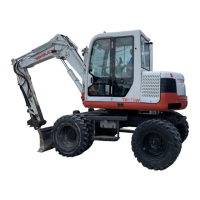Operating Precautions
Cautions on traveling on slopes
When traveling on slopes or grades, be
careful that the machine does not tip (roll)
over or slide.
Never exceed the machine’s stability
capabilities (maximum gradeability – 35°,
lateral tipping angle – 15°). Also note that
when actual working area conditions are
poor the machine’s stability capabilities
may be lower.
When traveling on slopes or grades, lower
the bucket to a height of 20 to 30 cm (8 to 12
in.) off the ground. In emergencies, lower the
bucket to the ground and stop the machine.
When traveling on slopes or grades, move
slowly at low speed.
Do not travel down slopes in reverse.
On grass, dead leaves, wet metal or frozen
surfaces, the machine may slide sideways
even on very gentle slopes. Make sure
the machine never faces sideways with
respect to the slope.
Do not travel at speeds of over 20 km/h
(12.4 mph) on long down slopes. Release
the travel pedal from time to time to protect
the travel motor and ensure travel stability.
Do not change directions or cross slopes
sideways. First return to a flat surface then
redirect the machine.
Operate on snow or ice with extra
care
When traveling on snow or frozen surfaces,
keep the machine travel speed down and
avoid accelerating, stopping or changing
directions abruptly.
Remember that the road shoulder, fences,
etc., may be buried in the snow and not
visible.
Lower the dozer blade when parked on
unsure ground conditions.
Do not carry the bucket over the
heads of people
Carrying the bucket over the heads of people
entails the danger of the load spilling or the
sudden dropping of the bucket.
90°~110°
Climbing
20~30cm
(8 to 12 in)
W2A010
90°~110°
Descending
20~30cm (8 to 12 in)
W2A009

